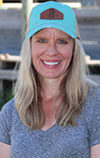We’ve heard the saying: If these walls could speak … oh, the stories they would tell. I think the same is true of land. If our land could talk, what would it say?
- That guy, he’s always frustrated about something.
- She yells a lot.
- He never stops singing.
- She talks to every blade of grass.
Or would it tell of the time your daughter got bucked off a horse and the soil cradled her until she was ready to get back on?
Or would it say thank you for moving the cows off before the ground became bare?
Maybe it’d breathe a sigh of relief when grumpy Uncle Gus finally left and his constant complaining left with him.
We’ve lived in a few different places over the years and, as odd as it sounds, I feel like the land speaks. I may not know specific details, but there are obvious clues as seen by the condition of the land. Is it dry? Down to just dirt? Full of dead plants? Burned? Lush? Green?
Sometimes there are subtle clues. Have you ever walked into a building and, as soon as your feet are in the door, you can’t wait to leave? I’ve felt that in pastures as well. In fact, one place we lived, the cattle had one pasture they hated to be in – even a new fence didn’t want to keep them in place. They would always go to the far east pasture instead, where they seemed to breathe a sigh of relief even though it took some effort for them to accomplish. We had cleaned up the pasture they didn’t like before we put them in it – it had been full of garbage and we’d given it time to rest and grow grass. The cows had never been in there when it was nasty; we don’t put animals in rough environments, but they seemed to “know” that it hadn’t always been cared for.
Also, animals are very intuitive. Sometimes we get frustrated with them because they aren’t going where we ask, but perhaps they are trying to tell us something. Sure, sometimes they want to go home or, if you’re moving pairs, it can get a bit interesting, especially if the calves are young. However, cows can sense danger. If things really seem off, maybe there’s a badger or a snake. Just because we can’t see it doesn’t mean it doesn’t exist.
The same is true for land. We once had a few head of cattle that ended up with foot rot – even though the normal conditions for foot rot didn’t exist. We found out later that several years prior to us being there, there were sheep on the land. Sheep can often carry fusobacterium, which leads to foot rot. (Not all foot rot is caused from fusobacterium, nor do all sheep carry it. It happened to be what we discovered on our leased pasture.) We supplemented specifically for that with our mineral, and we didn’t have any more problems.
Going back even further than a few years, though, can you imagine the scenes that must have unfolded on your land? What did it look like a hundred years ago?
We discovered an entry from Lewis’ journal (as in Lewis and Clark) that described a cliff overlooking the Jefferson River. It details land forms to such an extent that we are quite certain Lewis and Clark looked over the same cliff that we have looked over on our property. It is a humbling experience to think that back in time these famous explorers stared at the same space as you.
A friend of mine explained to me that she feels in awe of the land that way from previous generations because as a fifth-generation rancher, she has heard the stories of her great-great-grandparents and their story of buying land and beginning a ranch. She feels the heritage when she is outside and working with the animals. She knows that some of the fence that her family replaced was built by her grandparents.
I’ve also thought about land where wars were fought and how this impacts the history of the land. I’ve spoken prayers and blessings over land, asking God for peace where turmoil once reigned. It changes things.
While the history of the land tells a story, that story doesn’t limit the future. Obviously, we need to take heed of what the land is capable of producing – what it is best used for and how to best care for it – but we can use that history as a stepping stone into the future. This may mean grazing a pasture that has previously been farmed or changing a cover crop to put nutrients back into the soil. It may mean no-till drilling in high-wind areas.
Just like people, no story is the same. Each piece of land has its own story to tell.









